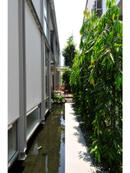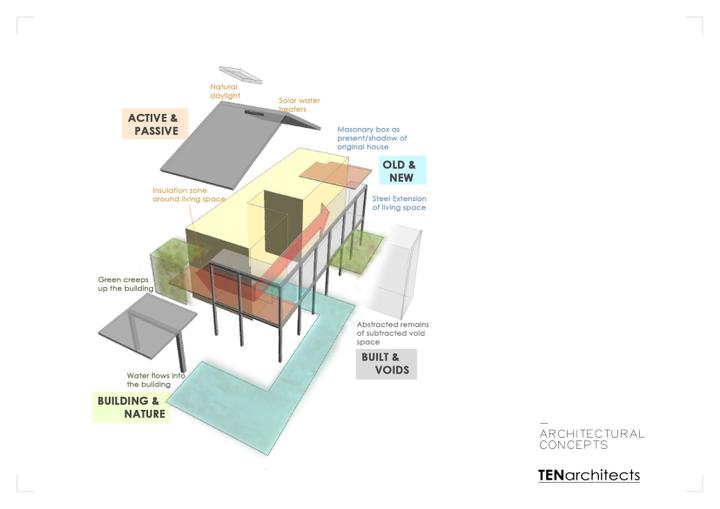1 / 17

















Project Details
The two-storey semi-detached house is reconstructed to update its appearance, add space and bring light and air deep into the interiors. The starting point involves working with the existing ungainly concrete and brick massing. The process of carving out voids from this solid element and the wrapping of a skin of steel and glass extension around the old structure generated an enduring dialogue between the parts – the old and the new, the solid and the voids, the inside and the out, the flow and the disruption.
Externally, a steel frame around the original masonry bulk forms a new and changeable layer on the façade, carrying infill window panels, screen walls, fabric blinds and green veils. New additions of lightweight nature contrast with the heavy old. Internally, the spaces are completely reorganized around a void that has been cut deep into the original old structure to bring light and air into the heart of the house.
The house seeks to minimize its impact on the environment through a combination of active and passive means:
- Reduction of waste: Retention of old structure and components as a basis for design. Building in steel and composite construction eliminates timber formwork
- Use of recycled materials: Old timber planks salvaged from the owner’s previous home were reconditioned and used as flooring material
- Use of renewable energy: Solar heater to generate hot water. Introduction of natural light deep into interior reduces dependency on artificial lighting
- Thermal cushions: Water bodies that collect, store and circulate rain water around the house create an environmental cushion against extreme fluctuations in thermal conditions
- Balance of built and green: Green dominates the house in both its natural form as well as cultivated green screensThe two-storey semi-detached house is reconstructed to update its appearance, add space and bring light and air deep into the interiors. The starting point involves working with the existing ungainly concrete and brick massing. The process of carving out voids from this solid element and the wrapping of a skin of steel and glass extension around the old structure generated an enduring dialogue between the parts – the old and the new, the solid and the voids, the inside and the out, the flow and the disruption.
Externally, a steel frame around the original masonry bulk forms a new and changeable layer on the façade, carrying infill window panels, screen walls, fabric blinds and green veils. New additions of lightweight nature contrast with the heavy old. Internally, the spaces are completely reorganized around a void that has been cut deep into the original old structure to bring light and air into the heart of the house.
The house seeks to minimize its impact on the environment through a combination of active and passive means:
- Reduction of waste: Retention of old structure and components as a basis for design. Building in steel and composite construction eliminates timber formwork
- Use of recycled materials: Old timber planks salvaged from the owner’s previous home were reconditioned and used as flooring material
- Use of renewable energy: Solar heater to generate hot water. Introduction of natural light deep into interior reduces dependency on artificial lighting
- Thermal cushions: Water bodies that collect, store and circulate rain water around the house create an environmental cushion against extreme fluctuations in thermal conditions
- Balance of built and green: Green dominates the house in both its natural form as well as cultivated green screensRead MoreHide
Area Size
323m²
Year of Completion
2010
Interior Style
Modern
Works included
Carpentry
Flooring
Hacking
False Ceiling
Painting
Plumbing
Feature Wall
Electrical Rewiring
Aircon
Tiling


















